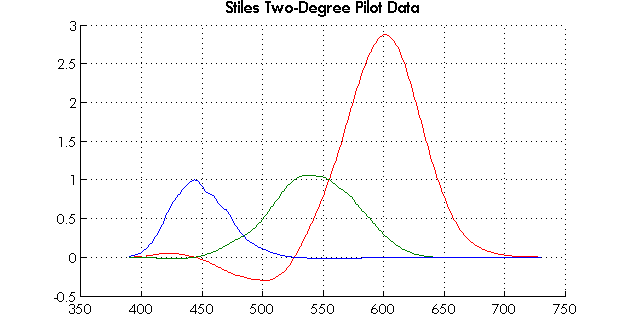As I was poking on the Internet for the interpolated 2º pilot color-matching data as functions of wavelength at intervals of 1 nm, I could not find it. As it is always nice to be able to go back to the "book" instead of converting from wavenumber and interpolating by oneself, I quickly scanned Table I(5.5.3) in Wyszecki and Stiles on the trusty old Digital Sender with the Kamakura engine I conceived back in 1991 and OCRed it with ABBYY FineReader 8.0 Professional and here it is:

% The Stiles & Burch 2-deg CMFs are based on measurements made in 10
% observers. The data are referred to as pilot data, but probably represent
% the best estimate of the 2 deg CMFs, since, unlike the CIE 2 deg
% functions (which were reconstructed from chromaticity data), they were
% measured directly.
%
% From Table I(5.5.3) of Wyszecki & Stiles (1982). (Table 1(5.5.3) of
% Wyszecki & Stiles (1982) gives the Stiles & Burch functions in 250
% cm^{-1} steps, while Table I(5.5.3) of Wyszecki & Stiles (1982) is gives
% them in interpolated 1 nm steps.)
%
% These CMFs differ slightly from those of Stiles & Burch (1955). As noted
% in footnote a on p. 335 of Table 1(5.5.3) of Wyszecki & Stiles (1982),
% the CMFs have been "corrected in accordance with instructions given by
% Stiles & Burch (1959)" and renormalized to primaries at 15500 (645.16),
% 19000 (526.32), and 22500 (444.44) cm^{-1} (nm).
%
cmf = [390, 0.18397*10^-2, -0.45393*10^-3, 0.12152*10^-1;
391, 0.22070*10^-2, -0.53474*10^-3, 0.14604*10^-1;
392, 0.26451*10^-2, -0.62941*10^-3, 0.17534*10^-1;
393, 0.31672*10^-2, -0.74019*10^-2, 0.21033*10^-1;
394, 0.37890*10^-2, -0.86974*10^-2, 0.25208*10^-1;
395, 0.46153*10^-2, -0.10464*10^-2, 0.31110*10^-1;
396, 0.54135*10^-2, -0.11995*10^-2, 0.36165*10^-1;
397, 0.62593*10^-2, -0.13528*10^-2, 0.41145*10^-1;
398, 0.72015*10^-2, -0.15386*10^-2, 0.46652*10^-1;
399, 0.83035*10^-2, -0.17975*10^-2, 0.53472*10^-1;
400, 0.96264*10^-2, -0.21689*10^-2, 0.62371*10^-1;
401, 0.11208*10^-2, -0.26695*10^-2, 0.73827*10^-1;
402, 0.13000*10^-2, -0.32299*10^-2, 0.87262*10^-1;
403, 0.14934*10^-2, -0.37616*10^-2, 0.10186;
404, 0.16943*10^-1, -0.41784*10^-2, 0.11682;
405, 0.18979*10^-1, -0.44304*10^-2, 0.13161;
406, 0.21071*10^-1, -0.46185*10^-2, 0.14684;
407, 0.23269*10^-1, -0.48824*10^-2, 0.16337;
408, 0.25621*10^-1, -0.53580*10^-2, 0.18206;
409, 0.28156*10^-1, -0.61520*10^-2, 0.20358;
410, 0.30803*10^-1, -0.72048*10^-2, 0.22750;
411, 0.33450*10^-1, -0.83929*10^-2, 0.25297;
412, 0.35991*10^-1, -0.95963*10^-2, 0.27918;
413, 0.38326*10^-1, -0.10704*10^-1, 0.30538;
414, 0.40459*10^-1, -0.11689*10^-1, 0.33172;
415, 0.42459*10^-1, -0.12579*10^-1, 0.35897;
416, 0.44398*10^-1, -0.13405*10^-1, 0.38787;
417, 0.46342*10^-1, -0.14194*10^-1, 0.41914;
418, 0.48282*10^-1, -0.14977*10^-1, 0.45284;
419, 0.50098*10^-1, -0.15786*10^-1, 0.48810;
420, 0.51662*10^-1, -0.16651*10^-1, 0.52396;
421, 0.52851*10^-1, -0.17603*10^-1, 0.55953;
422, 0.53564*10^-1, -0.18649*10^-1, 0.59396;
423, 0.53789*10^-1, -0.19688*10^-1, 0.62676;
424, 0.53542*10^-1, -0.20593*10^-1, 0.65752;
425, 0.52837*10^-1, -0.21240*10^-1, 0.68586;
426, 0.51690*10^-1, -0.21512*10^-1, 0.71140;
427, 0.50160*10^-1, -0.21404*10^-1, 0.73438;
428, 0.48348*10^-1, -0.21029*10^-1, 0.75560;
429, 0.46357*10^-1, -0.20502*10^-1, 0.77588;
430, 0.44287*10^-1, -0.19936*10^-1, 0.79604;
431, 0.42209*10^-1, -0.19414*10^-1, 0.81667;
432, 0.40065*10^-1, -0.18875*10^-1, 0.83746;
433, 0.37751*10^-1, -0.18212*10^-1, 0.85779;
434, 0.35168*10^-1, -0.17320*10^-1, 0.87703;
435, 0.32220*10^-1, -0.16097*10^-1, 0.89459;
436, 0.28888*10^-1, -0.14518*10^-1, 0.91025;
437, 0.25318*10^-1, -0.12711*10^-1, 0.92446;
438, 0.21671*10^-1, -0.10821*10^-1, 0.93780;
439, 0.18104*10^-1, -0.89882*10^-2, 0.95080;
440, 0.14763*10^-1, -0.73457*10^-2, 0.96395;
441, 0.11643*10^-1, -0.58873*10^-2, 0.97687;
442, 0.85576*10^-2, -0.44508*10^-2, 0.98815;
443, 0.53193*10^-2, -0.28691*10^-2, 0.99635;
444, 0.17441*10^-2, -0.97985*10^-3, 0.10001*10;
445, -0.23392*10^-2, 0.13690*10^-2, 0.99814;
446, -0.69620*10^-2, 0.42191*10^-2, 0.99033;
447, -0.12038*10^-1, 0.75200*10^-2, 0.97759;
448, -0.17481*10^-1, 0.11219*10^-1, 0.96083;
449, -0.23206*10^-1, 0.15266*10^-1, 0.94092;
450, -0.29130*10^-1, 0.19610*10^-1, 0.91875;
451, -0.35208*10^-1, 0.24189*10^-1, 0.89561;
452, -0.41419*10^-1, 0.28932*10^-1, 0.87310;
453, -0.47746*10^-1, 0.33770*10^-1, 0.85281;
454, -0.54170*10^-1, 0.38634*10^-1, 0.83625;
455, -0.60677*10^-1, 0.43464*10^-1, 0.82487;
456, -0.67291*10^-1, 0.48303*10^-1, 0.81815;
457, -0.74083*10^-1, 0.53311*10^-1, 0.81348;
458, -0.81124*10^-1, 0.58651*10^-1, 0.80820;
459, -0.88482*10^-1, 0.64481*10^-1, 0.79972;
460, -0.96224*10^-1, 0.70954*10^-1, 0.78554;
461, -0.10434, 0.78117*10^-1, 0.76479;
462, -0.11270, 0.85807*10^-1, 0.73987;
463, -0.12113, 0.93840*10^-1, 0.71354;
464, -0.12947, 0.10203, 0.68846;
465, -0.13759, 0.11022, 0.66723;
466, -0.14535, 0.11825, 0.65182;
467, -0.15284, 0.12620, 0.64089;
468, -0.16017, 0.13420, 0.63201;
469, -0.16747, 0.14239, 0.62281;
470, -0.17486, 0.15088, 0.61098;
471, -0.18247, 0.15981, 0.59430;
472, -0.19025, 0.16916, 0.57222;
473, -0.19801, 0.17875, 0.54617;
474, -0.20553, 0.18840, 0.51769;
475, -0.21260, 0.19794, 0.48829;
476, -0.21903, 0.20720, 0.45941;
477, -0.22465, 0.21603, 0.43234;
478, -0.22953, 0.22444, 0.40726;
479, -0.23386, 0.23255, 0.38389;
480, -0.23780, 0.24042, 0.36195;
481, -0.24153, 0.24816, 0.34118;
482, -0.24521, 0.25585, 0.32131;
483, -0.24896, 0.26359, 0.30216;
484, -0.25281, 0.27155, 0.28379;
485, -0.25674, 0.27993, 0.26634;
486, -0.26076, 0.28889, 0.24990;
487, -0.26485, 0.29862, 0.23458;
488, -0.26901, 0.30928, 0.22050;
489, -0.27319, 0.32095, 0.20767;
490, -0.27727, 0.33353, 0.19593;
491, -0.28109, 0.34686, 0.18509;
492, -0.28453, 0.36081, 0.17498;
493, -0.28744, 0.37526, 0.16541;
494, -0.28969, 0.39008, 0.15622;
495, -0.29125, 0.40521, 0.14730;
496, -0.29228, 0.42078, 0.13865;
497, -0.29298, 0.43696, 0.13031;
498, -0.29354, 0.45390, 0.12232;
499, -0.29415, 0.47173, 0.11470;
500, -0.29500, 0.49060, 0.10749;
501, -0.29616, 0.51059, 0.10071;
502, -0.29734, 0.53148, 0.94295*10^-1;
503, -0.29813, 0.55298, 0.88199*10^-1;
504, -0.29816, 0.57482, 0.82358*10^-1;
505, -0.29706, 0.59673, 0.76714*10^-1;
506, -0.29446, 0.61845, 0.71209*10^-1;
507, -0.29004, 0.63975, 0.65792*10^-1;
508, -0.28387, 0.66063, 0.60468*10^-1;
509, -0.27628, 0.68127, 0.55274*10^-1;
510, -0.26759, 0.70184, 0.50248*10^-1;
511, -0.25812, 0.72251, 0.45426*10^-1;
512, -0.24816, 0.74344, 0.40844*10^-1;
513, -0.23802, 0.76478, 0.36537*10^-1;
514, -0.22781, 0.78656, 0.32523*10^-1;
515, -0.21725, 0.80852, 0.28781*10^-1;
516, -0.20600, 0.83037, 0.25287*10^-1;
517, -0.19374, 0.85179, 0.22016*10^-1;
518, -0.18014, 0.87252, 0.18945*10^-1;
519, -0.16488, 0.89226, 0.16050*10^-1;
520, -0.14768, 0.91076, 0.13309*10^-1;
521, -0.12848, 0.92793, 0.10717*10^-1;
522, -0.10745, 0.94384, 0.82893*10^-2;
523, -0.84777*10^-1, 0.95857, 0.60380*10^-2;
524, -0.60631*10^-1, 0.97221, 0.39763*10^-2;
525, -0.35184*10^-1, 0.98482, 0.21170*10^-2;
526, -0.86031*10^-2, 0.99650, 0.47268*10^-3;
527, 0.18950*10^-1, 0.10073*10, -0.94755*10^-3;
528, 0.47338*10^-1, 0.10172*10, -0.21657*10^-2;
529, 0.76441*10^-1, 0.10261*10, -0.32223*10^-2;
530, 0.10614, 0.10339*10, -0.41574*10^-2;
531, 0.13633, 0.10405*10, -0.50101*10^-2;
532, 0.16688, 0.10459*10, -0.58186*10^-2;
533, 0.19770, 0.10499*10, -0.66202*10^-2;
534, 0.22868, 0.10525*10, -0.74487*10^-2;
535, 0.25981, 0.10538*10, -0.83032*10^-2;
536, 0.29116, 0.10542*10, -0.91612*10^-2;
537, 0.32277, 0.10539*10, -0.10001*10^-1;
538, 0.35471, 0.10531*10, -0.10799*10^-1;
539, 0.38702, 0.10521*10, -0.11536*10^-1;
540, 0.41976, 0.10512*10, -0.12191*10^-1;
541, 0.45298, 0.10507*10, -0.12742*10^-1;
542, 0.48676, 0.10505*10, -0.13188*10^-1;
543, 0.52121, 0.10504*10, -0.13543*10^-1;
544, 0.55645, 0.10502*10, -0.13822*10^-1;
545, 0.59259, 0.10498*10, -0.14039*10^-1;
546, 0.62973, 0.10489*10, -0.14210*10^-1;
547, 0.66800, 0.10473*10, -0.14348*10^-1;
548, 0.70748, 0.10448*10, -0.14468*10^-1;
549, 0.74822, 0.10413*10, -0.14579*10^-1;
550, 0.79004, 0.10368*10, -0.14681*10^-1;
551, 0.83271, 0.10312*10, -0.14770*10^-1;
552, 0.87603, 0.10245*10, -0.14845*10^-1;
553, 0.91978, 0.10168*10, -0.14901*10^-1;
554, 0.96376, 0.10080*10, -0.14936*10^-1;
555, 0.10078*10, 0.99826, -0.14947*10^-1;
556, 0.10516*10, 0.98745, -0.14931*10^-1;
557, 0.10953*10, 0.97574, -0.14888*10^-1;
558, 0.11391*10, 0.96338, -0.14819*10^-1;
559, 0.11834*10, 0.95066, -0.14727*10^-1;
560, 0.12283*10, 0.93783, -0.14613*10^-1;
561, 0.12743*10, 0.92515, -0.14480*10^-1;
562, 0.13215*10, 0.91287, -0.14328*10^-1;
563, 0.13702*10, 0.90123, -0.14160*10^-1;
564, 0.14206*10, 0.89044, -0.13978*10^-1;
565, 0.14727*10, 0.88039, -0.13782*10^-1;
566, 0.15262*10, 0.87070, -0.13575*10^-1;
567, 0.15807*10, 0.86100, -0.13357*10^-1;
568, 0.16360*10, 0.85095, -0.13129*10^-1;
569, 0.16917*10, 0.84018, -0.12893*10^-1;
570, 0.17476*10, 0.82835 -0.12650*10^-1;
571, 0.18034*10, 0.81513, -0.12401*10^-1;
572, 0.18589*10, 0.80020, -0.12147*10^-1;
573, 0.19138*10, 0.78362, -0.11888*10^-1;
574, 0.19680*10, 0.76573, -0.11625*10^-1;
575, 0.20214*10, 0.74686, -0.11356*10^-1;
576, 0.20739*10, 0.72735, -0.11082*10^-1;
577, 0.21254*10, 0.70752, -0.10803*10^-1;
578, 0.21757*10, 0.68770, -0.10518*10^-1;
579, 0.22247*10, 0.66819, -0.10228*10^-1;
580, 0.22724*10, 0.64930, -0.99317*10^-2;
581, 0.23186*10, 0.63117, -0.96303*10^-2;
582, 0.23635*10, 0.61365, -0.93258*10^-2;
583, 0.24069*10, 0.59659, -0.90203*10^-2;
584, 0.24489*10, 0.57981, -0.87159*10^-2;
585, 0.24896*10, 0.56317, -0.84148*10^-2;
586, 0.25289*10, 0.54649, -0.81188*10^-2;
587, 0.25668*10, 0.52963, -0.78300*10^-2;
588, 0.26034*10, 0.51245, -0.75502*10^-2;
589, 0.26387*10, 0.49480, -0.72812*10^-2;
590, 0.26725*10, 0.47675, -0.70210*10^-2;
591, 0.27044*10, 0.45842, -0.67665*10^-2;
592, 0.27344*10, 0.43993, -0.65146*10^-2;
593, 0.27620*10, 0.42143, -0.62622*10^-2;
594, 0.27871*10, 0.40302, -0.60062*10^-2;
595, 0.28093*10, 0.38484, -0.57437*10^-2;
596, 0.28286*10, 0.36699, -0.54718*10^-2;
597, 0.28445*10, 0.34961, -0.51875*10^-2;
598, 0.28570*10, 0.33277, -0.48896*10^-2;
599, 0.28660*10, 0.31647, -0.45831*10^-2;
600, 0.28717*10, 0.30069, -0.42743*10^-2;
601, 0.28742*10, 0.28539, -0.39696*10^-2;
602, 0.28734*10, 0.27056, -0.36751*10^-2;
603, 0.28695*10, 0.25615, -0.33970*10^-2;
604, 0.28625*10, 0.24215, -0.31410*10^-2;
605, 0.28525*10, 0.22853, -0.29132*10^-2;
606, 0.28397*10, 0.21526, -0.27191*10^-2;
607, 0.28240*10, 0.20233, -0.25626*10^-2;
608, 0.28055*10, 0.18975, -0.24398*10^-2;
609, 0.27842*10, 0.17755, -0.23441*10^-2;
610, 0.27601*10, 0.16575, -0.22693*10^-2;
611, 0.27333*10, 0.15438, -0.22092*10^-2;
612, 0.27037*10, 0.14347, -0.21577*10^-2;
613, 0.26714*10, 0.13305, -0.21090*10^-2;
614, 0.26365*10, 0.12313, -0.20572*10^-2;
615, 0.25989*10, 0.11373, -0.19966*10^-2;
616, 0.25586*10, 0.10489, -0.19220*10^-2;
617, 0.25158*10, 0.96593*10^-1, -0.18328*10^-2;
618, 0.24707*10, 0.88810*10^-1, -0.17319*10^-2;
619, 0.24235*10, 0.81516*10^-1, -0.16223*10^-2;
620, 0.23743*10, 0.74682*10^-1, -0.15069*10^-2;
621, 0.23234*10, 0.68282*10^-1, -0.13883*10^-2;
622, 0.22708*10, 0.62289*10^-1, -0.12695*10^-2;
623, 0.22169*10, 0.56679*10^-1, -0.11532*10^-2;
624, 0.21617*10, 0.51426*10^-1, -0.10418*10^-2;
625, 0.21054*10, 0.46504*10^-1, -0.93822*10^-3;
626, 0.20483*10, 0.41892*10^-1, -0.84426*10^-3;
627, 0.19904*10, 0.37578*10^-1, -0.75965*10^-3;
628, 0.19320*10, 0.33553*10^-1, -0.68351*10^-3;
629, 0.18733*10, 0.29807*10^-1, -0.61496*10^-3;
630, 0.18145*10, 0.26333*10^-1, -0.55316*10^-3;
631, 0.17557*10, 0.23120*10^-1, -0.49727*10^-3;
632, 0.16972*10, 0.20162*10^-1, -0.44648*10^-3;
633, 0.16390*10, 0.17448*10^-1, -0.39998*10^-3;
634, 0.15815*10, 0.14972*10^-1, -0.35697*10^-3;
635, 0.15247*10, 0.12724*10^-1, -0.31668*10^-3;
636, 0.14687*10, 0.10695*10^-1, -0.27849*10^-3;
637, 0.14137*10, 0.88722*10^-2, -0.24217*10^-3;
638, 0.13596*10, 0.72418*10^-2, -0.20760*10^-3;
639, 0.13065*10, 0.57899*10^-2, -0.17465*10^-3;
640, 0.12543*10, 0.45033*10^-2, -0.14319*10^-3;
641, 0.12030*10, 0.33688*10^-2, -0.11310*10^-3;
642, 0.11527*10, 0.23734*10^-2, -0.84268*10^-4;
643, 0.11033*10, 0.15045*10^-2, -0.56564*10^-4;
644, 0.10550*10, 0.74966*10^-3, -0.29873*10^-4;
645, 0.10076*10, 0.96611*10^-4, -0.40831*10^-5;
646, 0.96114, -0.46618*10^-3, 0.20896*10^-4;
647, 0.91577, -0.94692*10^-3, 0.45000*10^-4;
648, 0.87149, -0.13524*10^-2, 0.68102*10^-4;
649, 0.82835, -0.16894*10^-2, 0.90080*10^-4;
650, 0.78642, -0.19645*10^-2, 0.11081*10^-3;
651, 0.74574, -0.21840*10^-2, 0.13018*10^-3;
652, 0.70637, -0.23544*10^-2, 0.14807*10^-3;
653, 0.66835, -0.24819*10^-2, 0.16437*10^-3;
654, 0.63174, -0.25727*10^-2, 0.17897*10^-3;
655, 0.59659, -0.26327*10^-2, 0.19175*10^-3;
656, 0.56294, -0.26679*10^-2, 0.20261*10^-3;
657, 0.53081, -0.26828*10^-2, 0.21149*10^-3;
658, 0.50018, -0.26796*10^-2, 0.21842*10^-3;
659, 0.47099, -0.26601*10^-2, 0.22343*10^-3;
660, 0.44320, -0.26262*10^-2, 0.22656*10^-3;
661, 0.41679, -0.25797*10^-2, 0.22784*10^-3;
662, 0.39172, -0.25224*10^-2, 0.22731*10^-3;
663, 0.36793, -0.24560*10^-2, 0.22501*10^-3;
664, 0.34541, -0.23822*10^-2, 0.22096*10^-3;
665, 0.32410, -0.23027*10^-2, 0.21520*10^-3;
666, 0.30398, -0.22192*10^-2, 0.20776*10^-3;
667, 0.28502, -0.21332*10^-2, 0.19868*10^-3;
668, 0.26716, -0.20460*10^-2, 0.18809*10^-3;
669, 0.25035, -0.19581*10^-2, 0.17630*10^-3;
670, 0.23455, -0.18700*10^-2, 0.16361*10^-3;
671, 0.21971, -0.17822*10^-2, 0.15033*10^-3;
672, 0.20576, -0.16950*10^-2, 0.13675*10^-3;
673, 0.19267, -0.16090*10^-2, 0.12317*10^-3;
674, 0.18037, -0.15247*10^-2, 0.10988*10^-3;
675, 0.16884, -0.14424*10^-2, 0.97164*10^-4;
676, 0.15801, -0.13625*10^-2, 0.85290*10^-4;
677, 0.14784, -0.12856*10^-2, 0.74535*10^-4;
678, 0.13829, -0.12120*10^-2, 0.65168*10^-4;
679, 0.12930, -0.11420*10^-2, 0.57370*10^-4;
680, 0.12086, -0.10755*10^-2, 0.51033*10^-4;
681, 0.11294, -0.10124*10^-2, 0.45981*10^-4;
682, 0.10549, -0.95247*10^-3, 0.42045*10^-4;
683, 0.98510*10^-1, -0.89554*10^-3, 0.39058*10^-4;
684, 0.91958*10^-1, -0.84145*10^-3, 0.36853*10^-4;
685, 0.85811*10^-1, -0.79004*10^-3, 0.35271*10^-4;
686, 0.80044*10^-1, -0.74116*10^-3, 0.34151*10^-4;
687, 0.74630*10^-1, -0.69463*10^-3, 0.33338*10^-4;
688, 0.69544*10^-1, -0.65030*10^-3, 0.32676*10^-4;
689, 0.64762*10^-1, -0.60803*10^-3, 0.32017*10^-4;
690, 0.60260*10^-1, -0.56765*10^-3, 0.31211*10^-4;
691, 0.56019*10^-1, -0.52909*10^-3, 0.30183*10^-4;
692, 0.52029*10^-1, -0.49231*10^-3, 0.28963*10^-4;
693, 0.48282*10^-1, -0.45733*10^-3, 0.27587*10^-4;
694, 0.44769*10^-1, -0.42414*10^-3, 0.26090*10^-4;
695, 0.41480*10^-1, -0.39274*10^-3, 0.24508*10^-4;
696, 0.38408*10^-1, -0.36311*10^-3, 0.22876*10^-4;
697, 0.35543*10^-1, -0.33526*10^-3, 0.21228*10^-4;
698, 0.32878*10^-1, -0.30917*10^-3, 0.19597*10^-4;
699, 0.30405*10^-1, -0.28486*10^-3, 0.18018*10^-4;
700, 0.28114*10^-1, -0.26231*10^-3, 0.16521*10^-4;
701, 0.25999*10^-1, -0.24151*10^-3, 0.15140*10^-4;
702, 0.24051*10^-1, -0.22247*10^-3, 0.13905*10^-4;
703, 0.22261*10^-1, -0.20514*10^-3, 0.12833*10^-4;
704, 0.20620*10^-1, -0.18940*10^-3, 0.11911*10^-4;
705, 0.19117*10^-1, -0.17512*10^-3, 0.11124*10^-4;
706, 0.17740*10^-1, -0.16218*10^-3, 0.10457*10^-4;
707, 0.16481*10^-1, -0.15046*10^-3, 0.98953*10^-5;
708, 0.15329*10^-1, -0.13983*10^-3, 0.94242*10^-5;
709, 0.14273*10^-1, -0.13018*10^-3, 0.90293*10^-5;
710, 0.13305*10^-1, -0.12140*10^-3, 0.86965*10^-5;
711, 0.12415*10^-1, -0.11336*10^-3, 0.84120*10^-5;
712, 0.11593*10^-1, -0.10595*10^-3, 0.81621*10^-5;
713, 0.10829*10^-1, -0.99062*10^-4, 0.79333*10^-5;
714, 0.10116*10^-1, -0.92590*10^-4, 0.77125*10^-5;
715, 0.94092*10^-2, -0.85760*10^-4, 0.74351*10^-5;
716, 0.87394*10^-2, -0.79184*10^-4, 0.71463*10^-5;
717, 0.81190*10^-2, -0.73128*10^-4, 0.68695*10^-5;
718, 0.75441*10^-2, -0.67550*10^-4, 0.66041*10^-5;
719, 0.70114*10^-2, -0.62412*10^-4, 0.63497*10^-5;
720, 0.65177*10^-2, -0.57677*10^-4, 0.61057*10^-5;
721, 0.60599*10^-2, -0.53313*10^-4, 0.58718*10^-5;
722, 0.56354*10^-2, -0.49290*10^-4, 0.56474*10^-5;
723, 0.52417*10^-2, -0.45580*10^-4, 0.54322*10^-5;
724, 0.48765*10^-2, -0.42159*10^-4, 0.52258*10^-5;
725, 0.45377*10^-2, -0.39003*10^-4, 0.50277*10^-5;
726, 0.42232*10^-2, -0.36091*10^-4, 0.48377*10^-5;
727, 0.39313*10^-2, -0.33403*10^-4, 0.46553*10^-5;
728, 0.36600*10^-2, -0.30921*10^-4, 0.44728*10^-5;
729, 0.24081*10^-2, -0.28628*10^-4, 0.42952*10^-5;
730, 0.31742*10^-2, -0.26511*10^-4, 0.41251*10^-5];











